4th January 2021
The easing of Covid-19 restrictions over recent weeks created a window of opportunity for us to
‘escape’ the confines of metropolitan Melbourne. We jumped online and booked a campsite in the
National Park at Budj Bim (formerly Mt Eccles), about 4 hours drive south-west of Melbourne. Budj
Bim received Australia’s National Heritage listing in 2004 and is Victoria’s first co-managed
National Park as part of the 2007 Native Title Settlement Agreement. It became a recognised
UNESCO World Heritage site in 2019 and was the first indigenous site added specifically for its
cultural significance.
The National Park is significant for a number of reasons, most notably for the evidence of
extensive aquaculture practices dating back over 6,000 years. Budj Bim erupted over 30,000 years
ago with a massive larva flow that changed the landscape for ever, changing the flow of rivers and
creating inland lakes that supported the aquaculture practices that followed.
The National Park has a number of walks in and around the craters and lava flows, together with
camp grounds and facilities set amongst relatively flat, treed bush land. Altogether there are 22
campsites that have to be booked online – this can be done on arrival, as there is mobile phone
reception, but to avoid disappointment it is always safer to do so before departing.
After a Christmas and New Year period that seemed to be an endless procession of mild to warm
summer days, the weather turned wet (with Melbourne hit by afternoon thunderstorms that would
have been more at home in the tropics) as our departure approached. We packed the Tvan in
between showers of rain and closely watched the weather forecast to see what was likely in the
days ahead. The good news was the showers and storms would be clearing, but we would need to
endure a day or two of damp conditions until the sun and warmth reappeared.
Final packing was completed on the morning of departure (in between light showers) as the
contents of the fridge were transferred to the Tvan. We checked online to see what delays might
be happening on the Westgate bridge as a result of annual resurfacing works, to find that the work
had been completed and the traffic was moving at its usual pace. No reason to detour around the
Westgate this time.
The showers turned to heavy rain as we followed the Western Ring Road around to the Western
Highway and the latter through to Beaufort where we stopped for a light lunch. COVID-19
restrictions were being appropriately followed, with mask-wearing compliance being as good as we
have seen recently. Light showers continued on and off while we ate lunch; they persisted for some
time when back on the road.
We left the Western Highway before Ararat as we followed a network of back roads through
farmlands that were a mix of beef cattle, sheep, cropping and dairy cattle. Hay was being bailed up
at every opportunity, with some for local consumption and the remainder for sale interstate. It was
being loaded onto B-double trucks for the journey ahead.
The misty rain lifted for a short time after our arrival at the Budj Bim campground, but returned and
encouraged us to set up camp for wet conditions – annex, walls, ground mat and ensuite were all
erected to improve our comfort while the showers passed. As is our routine, we sat and enjoyed a
cup of tea once the camp set-up was complete before going for a stroll to get our bearings.
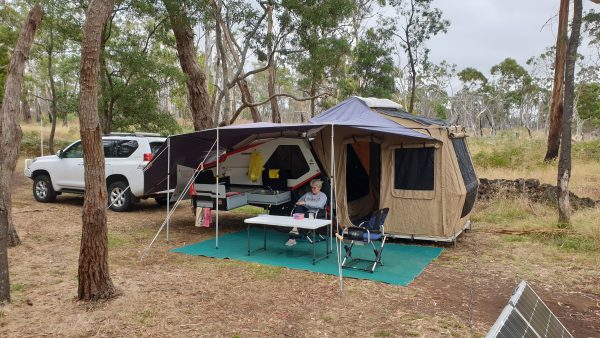

It was a short walk to the toilet facilities and then a little further on to the information boards outside
the ‘closed for renovation’ park office. We continued our walk to the Lake Surprise lookout and took
in the scenery that came into view. Lake Surprise has been formed in the remains of a volcanic
crater. The steep-sided crater has walks around the edge of the lake, some 50 to 80 metres below
the lookout. There are also walks around the crater rim and to the top of Mt Eccles. There are additional walks to the lava flows and to a cave formed by the movement of lava many, many years
ago. The walks were added to the list of things to do during our time in the National Park.

Our new fire pit was used for the first time since being purchased over 9 months ago. It came in
handy, cooking up the sausages that were part of our dinner. We retired early with the last rays of
daylight still in the sky and fell asleep to the sound of water falling from the trees overhanging our
campsite as the misty rain continued to swirl overhead.
The noise of koalas resolving territorial disputes could be heard nearby as darkness descended. It
was easy to understand how overseas visitors might be drawn in by stories of ‘drop bears’ if they
heard such threatening noises coming from the trees overhanging their campsite.
Wet day timetable
5th January 2021
The agenda for the day was decided by events last night when Chris became ‘that guy’ who triggers his car alarm when everyone else is contemplating going to bed. As it turns out, the battery in the remote locking device had finally called it quits and opening the car with the key was not executed in the correct manner, triggering the alarm. As a result, a trip to Toyota in Warrnambool was high on the list of ‘to dos’, in order to get the battery replaced.
The mist of the previous night was still our companion when we woke, so it was timely that we would spend some time in the shelter of the Prado as we followed more back roads to Warrnambool. The replacement battery was installed in no time flat and we were on our way a further 30 kms south west to Port Fairy for morning tea (and possibly some bread rolls for lunch).
Port Fairy was going off in terms of visitor numbers. We have visited here often over the years and this was as busy as we have ever seen it – maybe people really are travelling within their state this holiday season. Fuelled up on coffee and a shared muffin, we hit the streets in search of some bread rolls. The first bakery we checked out was doing a roaring trade selling pies and sausage rolls, but no bread rolls appealed so we continued our search. Our luck was in when we found some rolls that were more to our liking. A detour via the local hardware store that had pretty much all bases covered in terms of stock caught our eye. We walked away with a spray top for Wendy and some slip on Clogees for us both (in the hope we would slip them off before entering the Tvan back at camp).
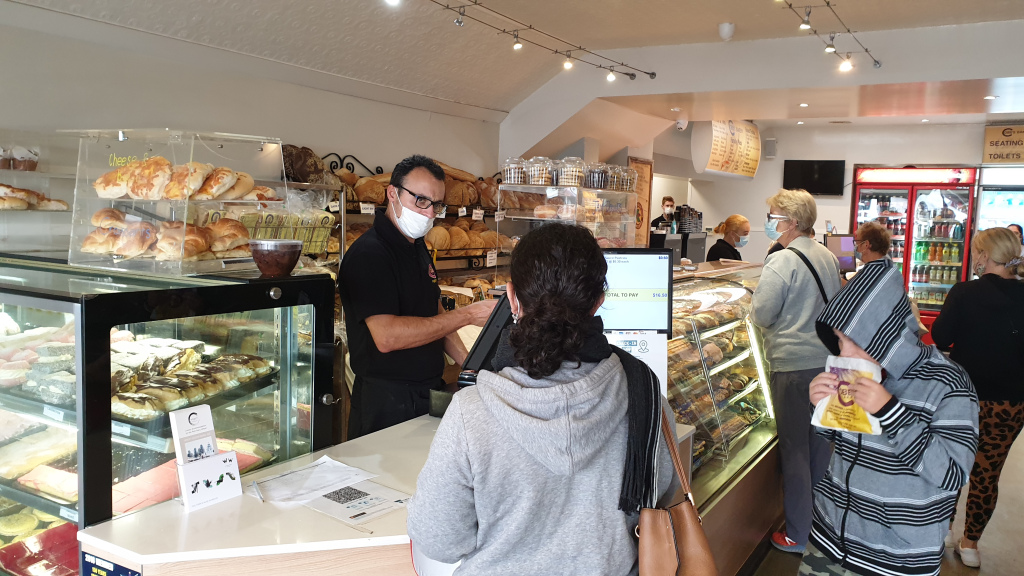
The misty rain continued as we drove back to our campsite in time for lunch. A quick stop before entering the National Park made good use of Tim’s electric chain saw as we stocked up on firewood from a fallen tree conveniently lying on the side of the road.

After lunch we set off to explore the Crater Rim walk that circumnavigates Lake Surprise. The crater lake is quite a size and provides some insight into just how big the eruption must have been all those years ago. The crater is now partially filled with water and a haven for local birdlife. We descended to explore a side walk that took us down a lengthy lava canal and into a cave formed by flowing lava. We eventually backtracked to the Crater Rim walk and scaled the highest point (Budj Bim) before returning to camp and settling in for afternoon tea and eventually dinner. It turned out to be a bit of a feast for dinner tonight, with eggplant and tomato ravioli in a homemade vegetable sauce and freshly grated cheese, accompanied by a Bests Shiraz that was up to the high standard maintained by the winery. All this was followed by fresh peaches and nectarines flame-grilled over an open fire and served with a drizzle of Tamar Valley honey and fresh yoghurt.

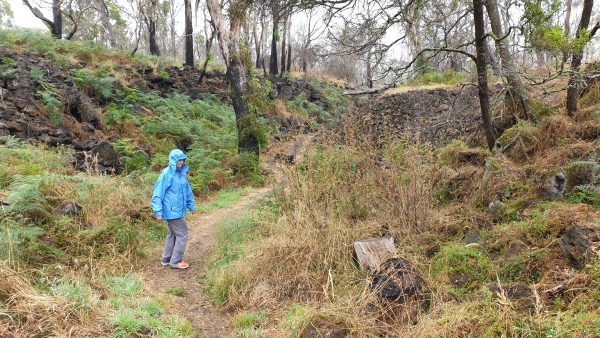
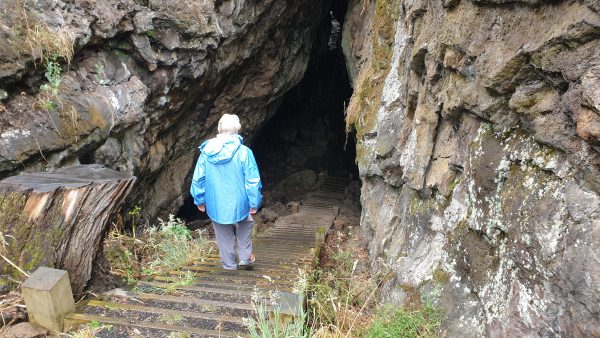
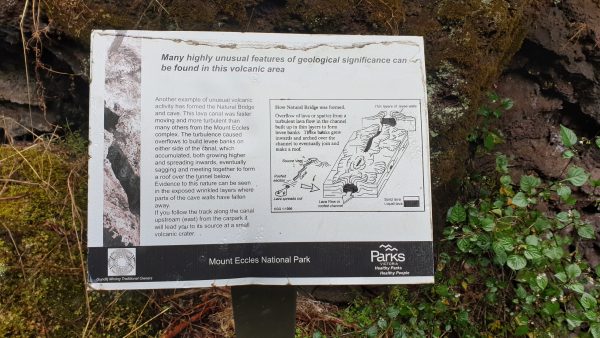
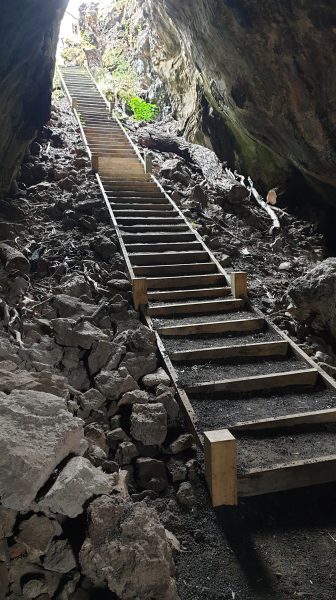


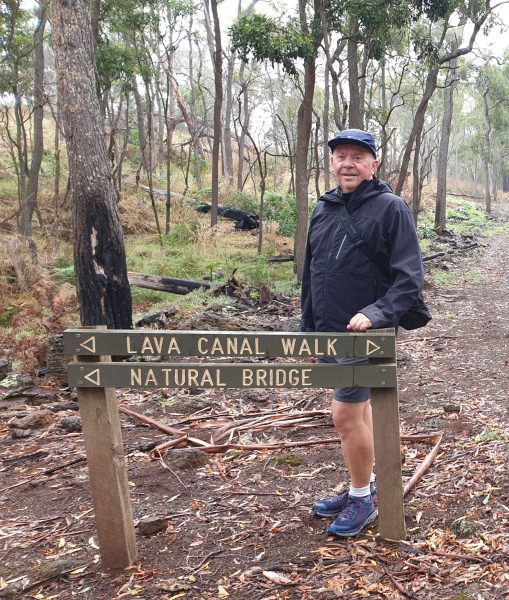
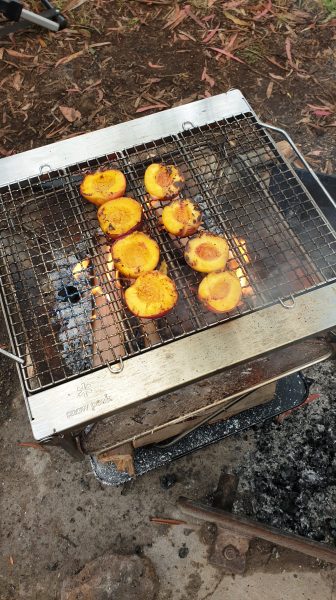
Exploring Budj Bim National Park
6th January 2021
What sounded like rain persisted on the roof of the Tvan throughout the night, but in actual fact it was heavy mist that gathered on the leaves of the overhanging trees and fell like rain when every puff of breeze passed through the treetops. As is often the case, the smaller birds were up and about at the first sign of dawn, followed about 30 minutes later by magpies and similar sized birds all eager to chat with their friends.
Patches of blue sky could be observed through the skylight above our bed as the clouds rolled by in the faint morning sun. Fingers were crossed for a drier day after a couple of days of on-again, off-again light showers. Chris was up and about first. The kettle was filled and popped on the stove while the water that had accumulated in the annex overnight was ‘encouraged’ to depart. Breakfast was consumed at a leisurely pace, with no pressure to be anywhere or do anything stirring us into action.
The light showers had eased so it was decided to attempt another of the numerous walks through the National Park. This time we set off on a lengthy walk that would circumnavigate the main features within the National Park. Our campsite is in a far corner of the campground and at a T-intersection for management vehicle tracks. We set off following the Northern Boundary Track (two wheel ruts cut through a bountiful crop of thistles), passing the turnoff to the Crater Rim Walk and continuing on parallel to an old dry stone wall built using the scoria (volcanic rock) that is in abundance in this area.

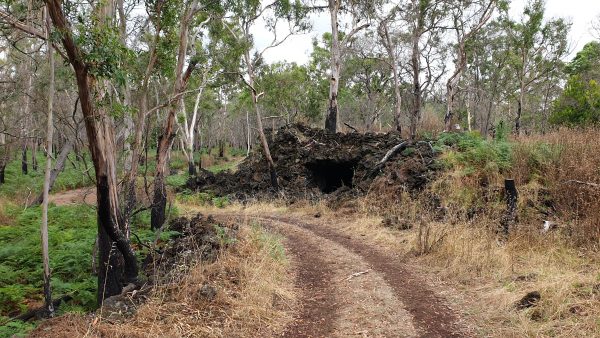
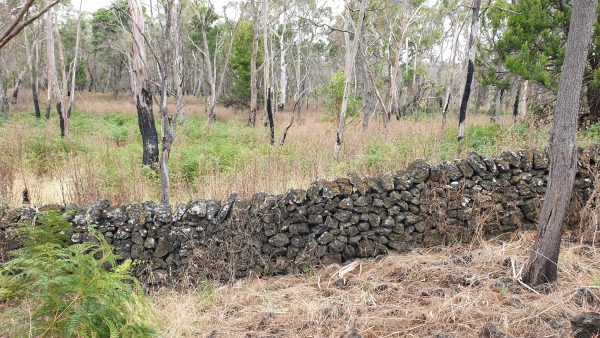
Chris tripped over while paying more attention to the dry stone walls and less to the path ahead. The scoria path removed a few layers of skin as he hit the ground. After dusting himself off and flushing the grazed palms and knees of any volcanic rocks, we were on our way again. The track ran parallel to the northern boundary of the National Park with stone walls and the remains of a significant lava flow to our right. The landscape changed as more and more volcanic activity dominated, with its obvious lava flows and lava canals. Another lava tunnel opened up in one of the larger lava flows. Unlike the tunnel we explored yesterday, this one was blocked at the far end.
We consulted our maps to see when we might pick up the walking track that would eventually lead us back to our campsite. We decided to continue on to the next track junction and reassess where we might head, depending on the quality of track ahead of us. The thick coverage of thistles was of concern, as we were managing to make our way on a vehicle track without getting prickled too much but this would be unlikely if the track narrowed to a single-file walking track. A large sheet of corrugated iron beside the track caught our attention. It was weighed down with two large rocks suggesting it was there for a purpose. What could it be covering? Possibly a collapsed roof of another lava cave below us? Chris was of the opinion that a sheet of corrugated iron in the Australian bush would be the guaranteed hiding place for local reptiles – most likely poisonous ones. So we left the corrugated iron sheeting undisturbed and continued on our way.
Our walk had been generally very peaceful with barely a sound to be heard but that all changed when we entered the domain of a flock of sulphur-crested cockatoos. Apparently their best defence is to make as much noise as possible. We had also managed to disturbed a few dark coloured wallabies, as well as a pair of small deer who moved quickly out of sight once they spotted us moving towards them.
Our map was eventually consulted when we had a choice to continue on in four possible directions. The most appealing direction was the one we had come from, as all other tracks looked overgrown and a scramble through thistles was not something we had come prepared for. Chris was in shorts! We retracted our footsteps, making it back to camp in time for lunch.
While preparing lunch we got the feeling a tour bus must have stopped at the start of the Crater Rim walk because group after group of holiday makers walked by our campsite on their circuit of the crater. Some looked prepared for the walk and others less so, dressed more for their instagram photos than a bush walk around an extinct volcano.
Well fed and rested from our morning walk we set off again after lunch to repeat the Crater Rim walk that we had completed yesterday in light showers and cloudy conditions that reduced visibility for much of the way. The visibility was much clearer today and it was worth having another look. We stopped at the summit of Budj Bim where a well-placed chair encouraged us to sit and take in the views of the surrounding hills and pastures. The descent to our campsite was far easier than the climb to the top of the hill.


Our firewood stocks were a little depleted, so we headed out of the National Park to collect more for the nights ahead. The fallen tree we collected firewood from was still where we found it yesterday, and in no time flat we had sufficient firewood for another night or two. The fire has been started and we have been enjoying a pre-dinner drink before another culinary treat for dinner tonight. Our local koala has been spotted high in a tree some 10 metres from our campsite. Grunts and growls and already been heard emanating from his ‘home’ high in the tree tops. Hopefully that is it for tonight and the noise abates before it gets dark.
Checking out the western district
7th January 2021
The weather forecast was for improving conditions, with warmer sunny days to follow the cloudy days with intermittent rain that had been the norm since our arrival at Budj Bim National Park. Chris set up the shower this morning, so we started the day feeling very refreshed and smelling less like a camp fire (for a while). It was decided to hit the road and explore some of the surrounding countryside, with a drive via Hamilton to Wannon Falls, which is on the road to Horsham.
We set off at a leisurely pace and before too long were parked up at a lookout with numerous information boards that described the impact the eruption of Mt Napier had on the landscape many thousands of years ago. It appears the eruption (and subsequent lava flows) reshaped the landscape. Fortunately the lava flows were at walking pace, allowing the indigenous people time to escape the fiery onslaught.
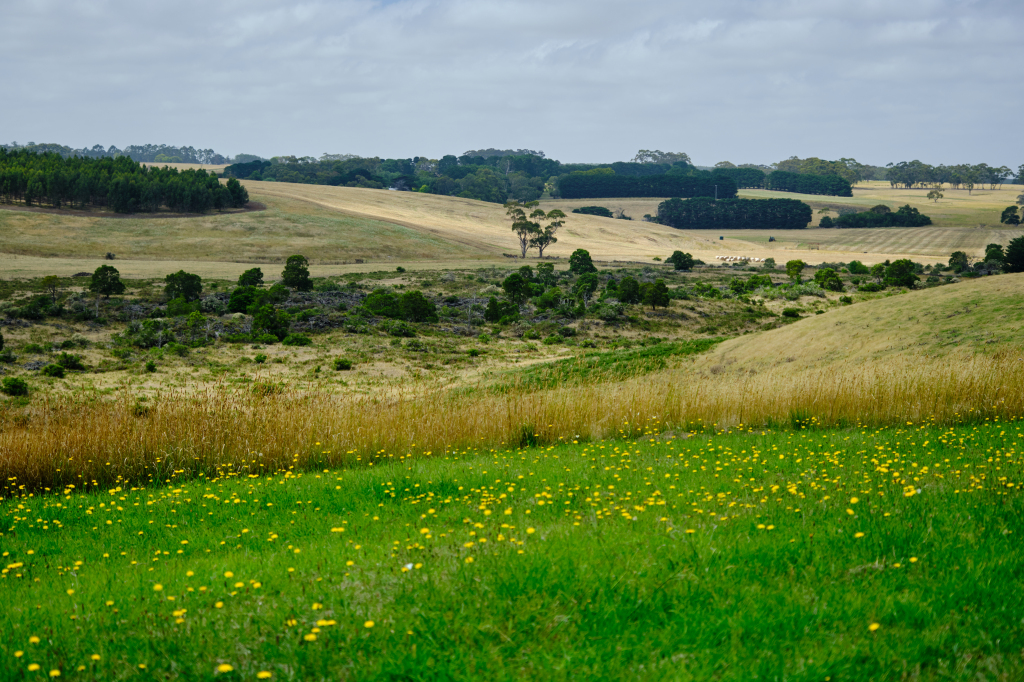
The legacy of the eruption has been fertile lands and a series of lava caves left over from the slowly moving lava flows that extended up to 27 kilometres from Mt Napier. A short distance down the road provided us with an opportunity to explore some of the remaining lava caves. A loop walk through the rocky landscape brought us abruptly to the entrance of one such cave – or more of a sink hole where the roof of the hollowed-out lava flow had collapsed, allowing entry to the cave below.
Chris ventured deeper into the cave before determining it was more an abseil than a caving expedition, and after taking a photo or two returned to the surface so that we could continue the walk past other cave entrances. Most caves remain closed to the public, as they are home to numerous bat populations that don’t do well when disturbed by visitors. According to the information boards, visitors to the caves (as determined by bones found in them) included kangaroos and Tasmanian tigers (from the time they inhabited the mainland).
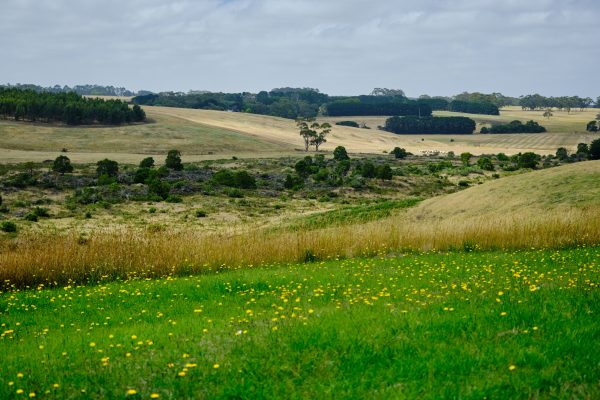

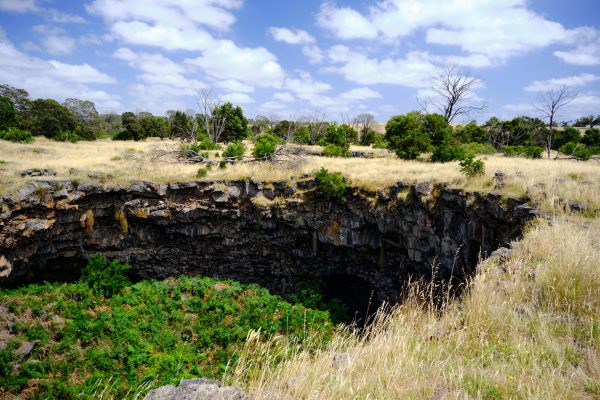
Our journey then took us over to Hamilton, where we sought out the local lake and a couple of geocaches that had been placed around the perimeter walk. We set off and were successful at finding one cache near a WW1 memorial. We gave up on the other, as it was located on an island in the lake and our only option of finding it involved either swimming or hiring a canoe! After completing the lake walk Trip Advisor was consulted for the best café in town, where we hoped to grab a late lunch and drink before setting off on the next leg of our day trip. Tosca Brown’s proved to be a great choice, and we left feeling very satisfied with our lunch choices.
Cheap diesel was available in Hamilton at $1.12 / litre so we topped up before continuing on to Wannon Falls, off the Hamilton-to-Mt Gambier road. Chris wondered whether the falls would be flowing, as we were now quite a few weeks into summer and maybe the flow had ceased until the next decent falls in autumn. This was definitely not the case, as the falls were cascading over a 20 metre drop into a chocolate brown pool below before continuing on their way via the Wannon and Glenelg rivers, to the south coast and into the Southern Ocean. The sun was now feeling quite intense, even though the temperature was showing a pleasant 23C. As a result, many children and some adults were enjoying a dip in the deeper rock pools upstream from the falls.
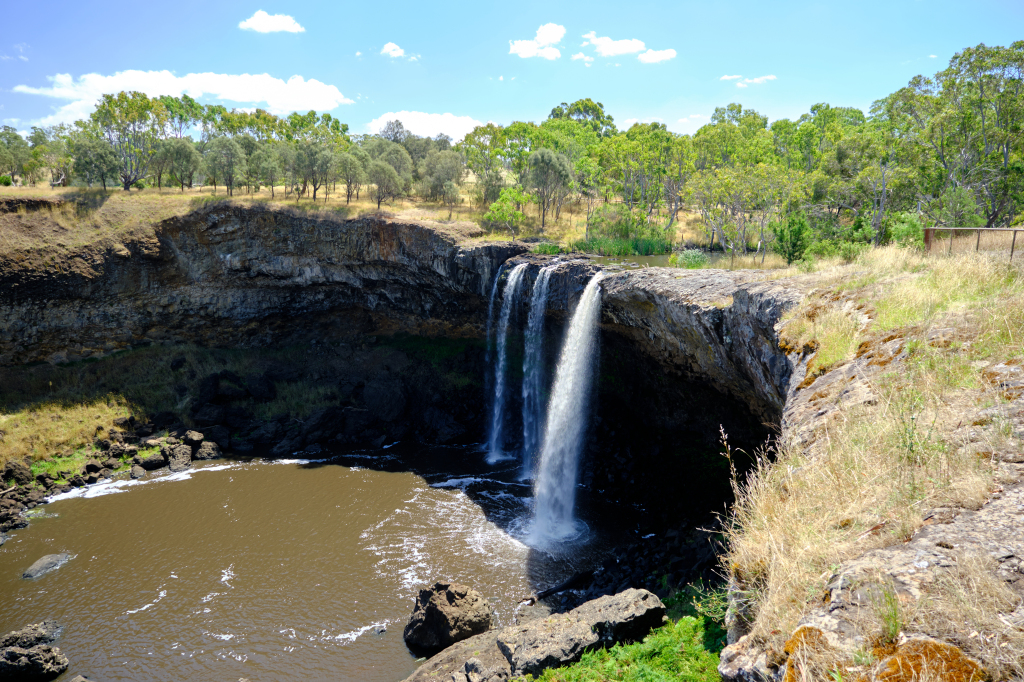
The return journey back to our campsite meandered through fertile pastures stocked largely with sheep, although more cattle were observed as we drew closer to Budj Bim NP. Maybe the soils change when closer to areas of greater volcanic activity, or maybe there is more rainfall as you approach the coast. We settled down to afternoon tea and a catch-up with family via FaceTime, as there is good internet coverage within the campground. The camp fire has been lit and dukkah-encrusted chicken fillets cooked over hot coals are top of the menu tonight. The pinot noir has already been opened and we are in for a pleasant evening.
Enjoying sunny conditions
8th January 2021
We woke to another stunning morning after a bit of a sleep in, and put the shower to good use before stepping outside for breakfast. It was easy to watch the world go by as we did nothing in particular.
At one stage rustling noises from a tall gum tree near the Tvan caught Chris’s attention. There, about a metre above the ground, was a koala looking to move to another tree in the neighbourhood. The koala stopped short of the ground when our movements (to grab cameras) became apparent. An assortment of photos and video clips were taken as our neighbour made it to the ground and continued on up the track to the next campsite, only to stop every now and then to survey each of the trees it passed along the way. A suitable new home was found and a slow but steady climb up to an obliging fork in the tree was all that could be managed before the koala settled down for another sleep.
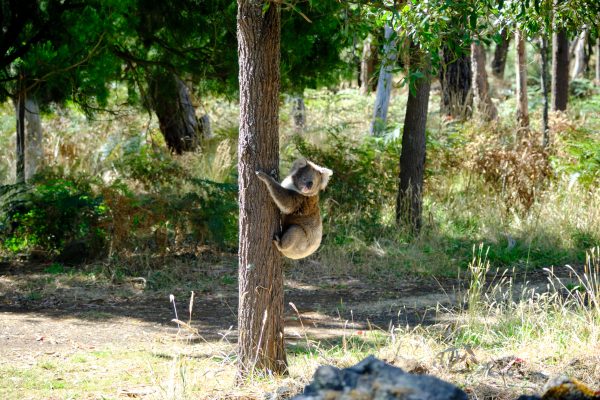

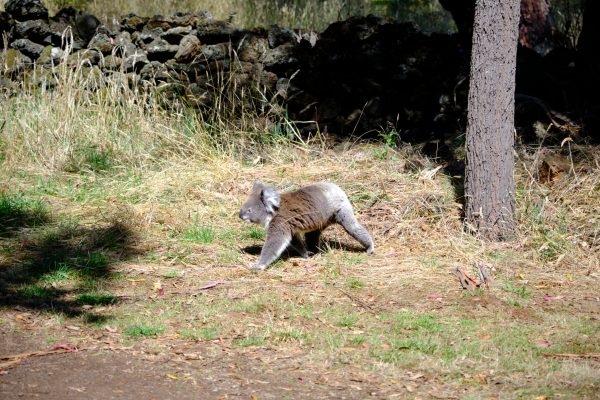
Day-trippers typically start out on the Crater Rim walk that takes them behind our campsite, often with comments like “they are well set up” and “look, they have solar panels” being heard as they passed by. The campground is set out along a tight, single lane track that is better suited for single vehicles and not ones towing large caravans. As a result, all but two sites are occupied by people in tents, with ourselves and another modest (in terms of size) camper trailer set up at Budj Bim.
Most of the people staying here in groups of more than 1 family have large, family-sized tents arranged around a central gazebo where the cooking and eating takes place. Another area is dedicated to the campfire, where seats are arranged in a circular pattern so all present can gaze into the smoking fires that do well to keep the insects at bay. Some campsites appear to have everything including the kitchen sink, while others have the basic single burner stove with a plate, bowl and cup per camper.
After a slow breakfast, Chris packed away the hot water system used to shower with, while we left the ensuite walls in place to dry out during the day. It’s always easier to let things dry out before they are packed away rather than having to unpack them when we get home to ensure they are dried properly. We will pack away the solar panels as the sun sets so it is something else we don’t have to worry about in the morning.
After lunch we set off for the last of the documented walks at Budj Bim NP – the Lake Surprise walk. This walk starts off with a steep descent into the crater that is central to the National Park (and a short walk from our campsite). The crater acts as a natural catchment, with no exit point above ground – although we assume evaporation and some loss from underground seepage helps to maintain the lake at a constant level. According to the information boards near the National Park office (now closed, as it is being made ready for a significant makeover) the crater was formed by three “vents” when it erupted thousands of years ago. Swimming in the lake is discouraged, due to a persistent outbreak of blue-green algae.

The circuit walk was about 2.5 kms in length and maintained a fairly consistent height (around 3 metres) above the water level. It undulated over rocky outcrops and around large trees. Some rustling in the bushes to our left caught our attention; it was an echidna with its head drilling down under a fallen tree seeking out its next meal. It wasn’t happy with our presence and curled up into a ball to avoid us as best it could.
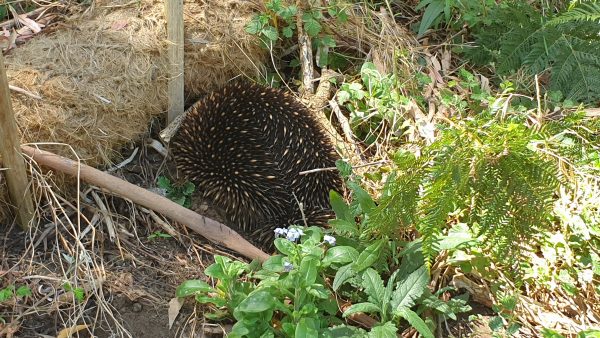
It’s interesting how sound travels over water. Other walkers who were undertaking a lap of Lake Surprise could be clearly heard opposite us as they were offering encouragement to their young children to continue on along the path. We observed that their progress was slow, with numerous interruptions to offer up ever more frequent words of encouragement. Eventually we came upon this group, mentioning to them the echidna that we had seen. We thought this could be used as an inducement to the younger members of the group to ‘keep going’.


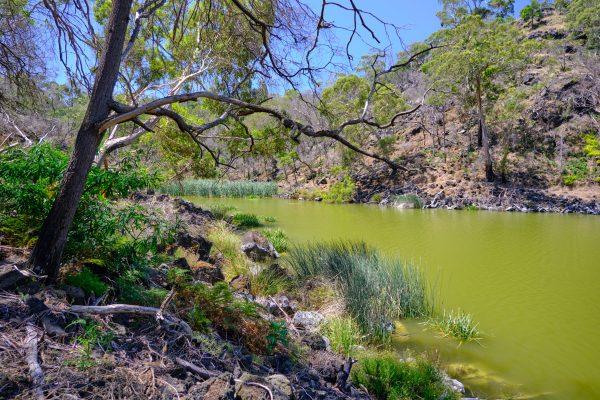
As we returned to our campsite, two ladies representing the CFA were doing a walkthrough of the grounds. Armed with bright red buckets they were wandering into each campsite and engaging the campers. We assumed they were fundraising – and what a good place to do so, especially at this time of year. Campers leaving campfires that have not been properly extinguished have been a problem this season, so getting the message out is important. As it turns out they stopped in at our campsite and were on a mission to hand out the bright red buckets with a message to extinguish camp fires before leaving. We had already raided Wendy’s purse for our donation that wasn’t called for.
We have returned to the comfort of our now familiar campsite for the day. The koalas are settling into their new abodes with lots of guttural noises emanating from the tree tops – as a signal to say “here I am” or possibly “this is now my tree so stay away”. Chris is a little concerned that one has taken up residence directly above the Prado and he is worried that it may be used for target practice by the resident koala.
News of the absolute debacle in Washington keeps filtering through, interrupted by statements being issued from the National Cabinet meeting held today regarding Covid-19. It must be summer in Australia, as these history making events are also interrupted by updates to the cricket scores from the match between Australia and India (being played in front of a greatly reduced crowd at the SCG). We will sit around the campfire tonight oblivious to all this, as the sun sets and the evening stars appear in a clear cloudless sky overhead.
The journey home
9th January 2021
Another beautiful day greeted us as we woke to the familiar sounds of the local birds, wallabies and koalas stirring in the early morning sun. A relaxed breakfast was enjoyed in the warming sunlight while we planned our route home. We had the chance of catching up with Tim and Craig who were planning to set up camp at Lake Toolyabuk. A quick phone call confirmed they were on their way, and that they would confirm access once they set up camp. We would await their call before locking in our route home.

The packing up routine is one that is familiar to us both now, as we have (over time) gravitated to specific chores. Chris, being taller, deals with those tasks that require a greater reach, while Wendy tends to tasks such as the challenge of folding ground mats correctly so they fit into undersized carry bags. Everything was finally packed away, and after a final check around the campsite for any missed items we were on our way in a generally easterly direction. Tim confirmed that their campsite beside the lake would be a tight squeeze for us with the Tvan in tow, so we agreed to catch up when back in Melbourne.
Our journey took us along back roads with a stop in Mortlake for morning tea where we bought some freshly made ham and salad rolls for our lunch later in the day. The back roads were quiet with little traffic to deal with along the way. We rejoined the Princes Highway to the west of Camperdown and noticed the increase in traffic straight away. Camperdown with its wide streets and well established trees provided a sheltered place to stop and enjoy the previously bought salad rolls containing everything that makes them a ‘country’ salad roll with beetroot, onion, cheese, lettuce, cucumber and thick-cut ham encased in a crusty white bread roll.
Following lunch we continued on to Colac, where we detoured south to a pick-your-own blueberry farm close to Gellibrand in the Otway Ranges. The blueberry farm was on a hillside, with the entire crop under netting to keep birds and bats out. We mastered our picking technique with a bit of practice and soon had over 2 kgs of blueberries tipping the scales. These were despatched to to the fridge in the Tvan for the journey home.
Traffic increased as we approached Geelong. The bypass that skirts Geelong helps to get around the ever-growing city, and the city of Melbourne eventually came into sight. A stretch of the freeway around Altona was closed for upgrade works, so a detour directed us through some Footscray backstreets before reconnecting with the Westgate Freeway. Being a sunny day, we chose to avoid Beach Road (and the likely crowds and traffic around the beaches) and instead followed Nepean Highway, returning home at around 5:00pm.
The routine on our return home is also well rehearsed, with the soiled camping clothes put through the wash, bed linen stripped from the bed and also washed, fridge (including blueberries) emptied and given a wipe over, and pantry items replenished (teas, matches, sauces, etc.) for the next trip away. The water tank has been flushed and refilled. Items stored in the rear of the Prado (eg. solar panel, recovery gear, cameras, iPads, etc.) are also removed and packed away.
Thoughts of the next trip away are already taking shape. Leaving the Tvan packed makes it easier to just get up and go when the opportunity presents. Non-Tvan trips to Tasmania, Noosa, Bendigo and the Grampians are already locked in for 2021 (COVID dependent).
